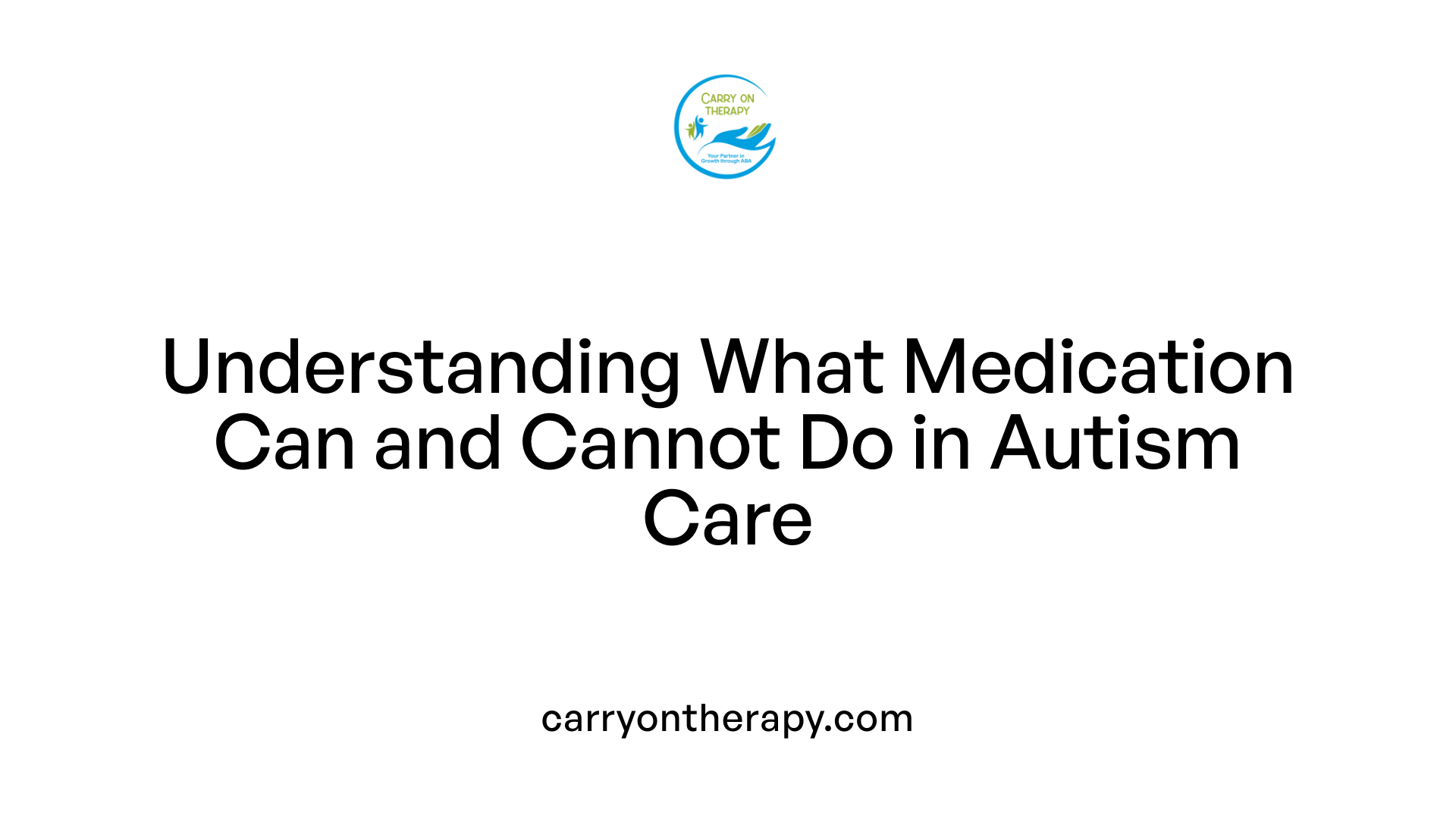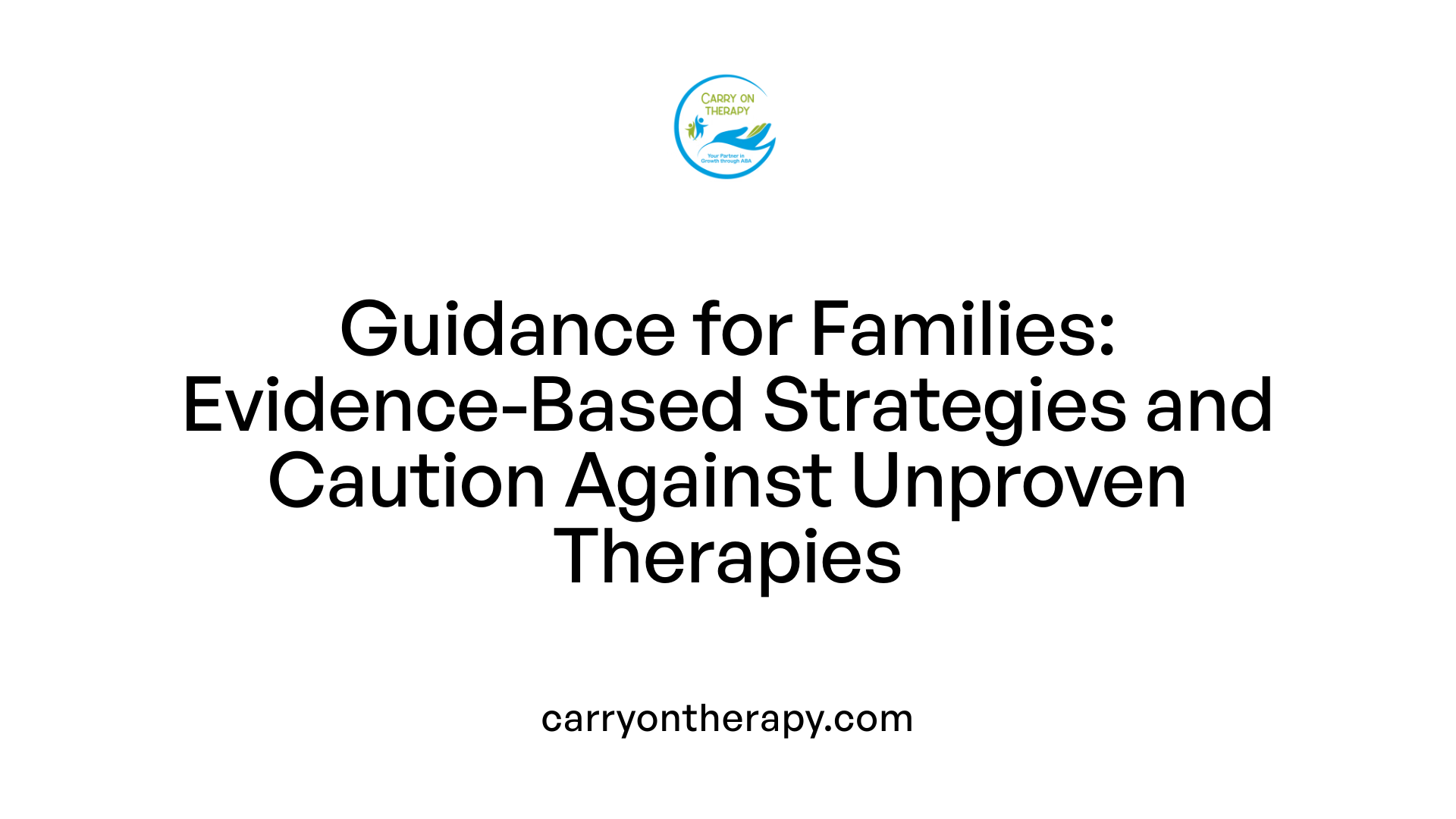Understanding the Role of Medication in Autism Spectrum Disorder
Medication often complements behavioral therapies in managing autism spectrum disorder (ASD). While there are no drugs that cure core symptoms of autism, pharmacological treatments can alleviate specific challenges such as irritability, hyperactivity, anxiety, and sleep difficulties, enabling individuals to function more effectively in daily life. This article explores the use of medications alongside behavioral interventions, the types of medications commonly prescribed, and the importance of personalized treatment planning supported by evidence-based therapies like Applied Behavior Analysis (ABA).
The Purpose and Limits of Medication in Autism Treatment

Are there medications that treat core symptoms of autism?
Medications do not treat the core symptoms of autism spectrum disorder (ASD), which include communication difficulties, social challenges, and repetitive behaviors. Instead, pharmacological treatments focus on managing co-occurring behaviors such as irritability, hyperactivity, anxiety, sleep disturbances, and mood disorders.
Medications for managing co-occurring behaviors in ASD
To help individuals with ASD function successfully, medications are often added alongside behavioral therapies. The main goal of these medications is to reduce symptoms like irritability, aggression, tantrums, self-injury, hyperactivity, and anxiety, which can interfere with daily functioning.
FDA-approved drugs for autism-related irritability
Two drugs are FDA-approved specifically for treating irritability associated with autism:
- Risperidone (approved in 2006 for children aged 5 years and older) helps reduce irritability and aggressive behaviors.
- Aripiprazole (approved in 2009 for children aged 6 to 17 years) similarly targets irritability and self-injurious behavior.
Both medications have shown effectiveness in managing these symptoms and can improve sociability indirectly by reducing challenging behaviors.
Use of off-label medications in autism
Many other medications are prescribed off-label for managing associated symptoms in ASD. Examples include:
- Selective serotonin reuptake inhibitors (SSRIs) like fluoxetine to address anxiety, depression, and sometimes repetitive behaviors.
- Methylphenidate to improve hyperactivity and inattention, similar to its use in ADHD.
- Melatonin and mirtazapine for sleep disturbances.
Off-label use allows clinicians to target specific symptoms but requires careful monitoring for side effects and individual responses.
The necessity of combining medication with behavioral therapies
Medication is most effective when combined with behavioral therapies such as applied behavior analysis (ABA) or speech therapy. Behavioral interventions remain the mainstay for addressing the core features of autism by promoting communication, social skills, and adaptive behaviors. Pharmacological treatments can enhance the benefits of therapy by stabilizing mood or reducing interfering behaviors, enabling better engagement in interventions.
FDA-Approved Medications Specifically Targeting Autism-Related Irritability
Which medications are FDA-approved for autism?
Risperidone and aripiprazole are the only medications specifically approved by the U.S. Food and Drug Administration (FDA) for treating symptoms associated with autism spectrum disorder (ASD).
Risperidone approval and usage
Risperidone gained FDA approval in 2006 for use in children aged 5 years and older. It is prescribed primarily to manage irritability in children with ASD. Through its effects on irritability, risperidone helps reduce tantrums, aggressive behaviors, and self-injury, which can significantly improve social interactions and overall functioning.
Aripiprazole approval and usage
Aripiprazole followed with FDA approval in 2009 for treating irritability in children between the ages of 6 and 17. Similar to risperidone, it is used to control irritability symptoms tied to autism, including aggression, tantrums, and self-harming behaviors. Both medications require careful medical supervision due to potential side effects and individual response variability.
Impact on irritability, tantrums, aggression, and self-injury
Both drugs specifically target irritability, which encompasses mood swings, severe tantrums, aggression, and self-injurious actions in children with ASD. By managing these challenging symptoms, risperidone and aripiprazole can enhance participation and engagement in behavioral therapies and daily activities.
Age ranges for approved medications
- Risperidone: Approved for children aged 5 years and older
- Aripiprazole: Approved for children aged 6 to 17 years
This targeted approval supports using these medications within well-defined pediatric populations to address autism-related irritability effectively, complementing behavioral interventions for comprehensive care.
Other Pharmacological Options in Autism Treatment
What other medications are used in treating autism symptoms?
In addition to FDA-approved drugs risperidone and aripiprazole, a variety of other medications are used off-label to manage symptoms and co-occurring conditions in autism spectrum disorder (ASD). These include selective serotonin reuptake inhibitors (SSRIs) such as fluoxetine, which may help reduce repetitive behaviors, although evidence is mixed. Methylphenidate is often prescribed to improve hyperactivity and inattention, paralleling its use in attention-deficit/hyperactivity disorder (ADHD).
Melatonin can effectively address sleep disturbances commonly seen in ASD, while oxytocin nasal spray shows promise in enhancing social functioning and emotion recognition. Other pharmacotherapies discussed include clozapine and haloperidol, which belong to the antipsychotic class but are generally prescribed cautiously due to potential side effects.
Several agents under investigation or used cautiously include bumetanide, which showed some efficacy but carries risks of significant diuresis and electrolyte imbalance; rivastigmine, which may improve cognition; and naltrexone, sometimes used to reduce self-injurious behaviors.
Potential benefits and risks
While these medications can target specific ASD-related challenges—such as hyperactivity, repetitive behaviors, cognition, or sleep problems—they come with variability in individual response and potential side effects. For example, stimulants like methylphenidate might increase anxiety in some individuals, and antipsychotics can cause weight gain or sedation. Thus, personalized treatment plans and close monitoring by healthcare providers are essential to balance benefits with risks.
Overall, when combined thoughtfully with behavioral interventions, these pharmacological options can contribute to improved daily functioning and quality of life for individuals with autism.
Medication Management and Personalized Treatment Planning

How is medication use managed in autism treatment?
Medication response in individuals with autism spectrum disorder (ASD) can vary significantly. Factors such as side effects, tolerance development, and fluctuating effectiveness necessitate ongoing monitoring and adjustment of treatment plans. This variability underscores the need for personalized medication management tailored to each individual's unique profile.
Collaboration with qualified medical professionals is vital to ensure safety and efficacy. Physicians oversee prescribing, dosage adjustments, and side effect monitoring, working closely with families and therapists to align pharmacological treatments with behavioral interventions.
Tools like the Medication Decision Tool Kit provide valuable support by helping medical providers and families make informed treatment decisions. These resources facilitate discussion about potential benefits, risks, and alternatives, promoting transparency and shared decision-making.
Medication is most effective when integrated into comprehensive care strategies that include behavioral therapies such as applied behavior analysis (ABA), speech therapy, and occupational therapy. Together, these approaches address both core ASD symptoms and co-occurring challenges like irritability, hyperactivity, anxiety, and sleep disturbances.
Ultimately, managing medication in autism requires a dynamic, individualized approach backed by professional guidance, careful observation, and collaboration to optimize outcomes and enhance quality of life.
Applied Behavior Analysis (ABA): A Cornerstone Therapy for Autism

What is applied behavior analysis (ABA) therapy and how does it help individuals with autism?
Applied Behavior Analysis (ABA) therapy is a scientifically supported approach that focuses on improving social, communication, and learning skills in individuals with autism. This therapy is centered on understanding and modifying behaviors through systematic interventions.
Scientific basis and individualized approach
ABA uses principles from behavioral psychology to assess behaviors and their antecedents and consequences. Treatment plans are personalized to fit the unique needs of each individual, focusing on encouraging positive behaviors while minimizing problematic ones through techniques like positive reinforcement.
How ABA improves social, communication, and learning skills
ABA targets specific skills such as language development, social interaction, and adaptive behaviors. Through repeated practice and reinforcement, individuals learn new skills that can be generalized across different situations, leading to meaningful improvements in their daily functioning.
Settings for ABA implementation
This therapy can be delivered in various environments, including the home, school, and community settings. Flexibility in location allows ABA to be integrated into the individual's everyday life, helping the person practice skills in natural contexts.
Goals of ABA therapy
The ultimate goal of ABA is to enhance the individual's independence and quality of life by promoting useful behaviors and reducing those that interfere with learning or social engagement. This evidence-based method is regarded as a cornerstone in autism treatment due to its measurable and positive impact on developmental outcomes.
Professional Providers of ABA Therapy and Team Involvement
Who typically provides ABA therapy for individuals with autism?
ABA therapy is delivered by a multidisciplinary team to ensure effective treatment tailored to each individual's needs.
Role of BCBAs, BCaBAs, and RBTs
Board Certified Behavior Analysts (BCBAs) lead ABA programs by designing customized treatment plans based on assessment data. They supervise all aspects of therapy, monitor progress, and make necessary adjustments. Board Certified Assistant Behavior Analysts (BCaBAs) support BCBAs by implementing components of these plans under supervision. Registered Behavior Technicians (RBTs) carry out hands-on therapy sessions with individuals, applying the strategies defined by BCBAs and BCaBAs.
Supervision and implementation of ABA programs
BCBAs oversee the entire implementation process, ensuring that therapy is consistent and evidence-based. They provide ongoing training and feedback to RBTs and BCaBAs to maintain treatment fidelity.
Involvement of paraprofessionals and therapists
Paraprofessionals often assist in daily therapy activities, supporting the RBTs and therapists. Other therapists—like speech, occupational, or physical therapists—may work alongside ABA teams to address specific developmental goals, reinforcing gains across settings.
Importance of parent training and engagement
Parental involvement is essential for maximizing outcomes. Parents receive training from BCBAs to apply ABA techniques consistently at home and in community settings. This partnership increases generalization of skills and fosters a supportive environment for learning and growth.
Main Goals and Focus Areas of ABA Therapy in Autism Treatment

What are the main goals of ABA therapy in autism treatment?
Applied Behavior Analysis (ABA) therapy focuses on several critical goals to support individuals with autism spectrum disorder (ASD) in achieving a higher quality of life.
First, ABA therapy targets the development of functional communication skills. This includes encouraging meaningful requesting, expressive language, and social interaction abilities tailored to each individual's needs.
Second, it emphasizes the enhancement of social and daily living skills. These include teaching appropriate social behaviors, cooperation, and essential daily activities such as dressing, eating, and hygiene.
Third, ABA works on the reduction of harmful or interfering behaviors like aggression, self-injury, or tantrums, replacing them with more positive, adaptive actions.
Next, the therapy focuses on improvement of cognitive and academic skills, helping individuals develop receptive language, problem-solving abilities, and school readiness.
Finally, ABA promotes community functioning and independence by teaching skills that enable individuals to participate safely and effectively in home, school, and community settings.
Together, these goals make ABA a comprehensive approach to helping individuals with ASD acquire vital skills, reduce difficulties, and foster greater independence.
Measuring Progress in ABA Therapy: Tools and Techniques
How is progress measured during ABA therapy for autism?
Progress in Applied Behavior Analysis (ABA) therapy is carefully measured using structured data collection methods designed to capture changes in targeted behaviors. Therapists commonly utilize frequency counts, where each instance of a behavior is tallied, and interval recordings, which record whether a behavior occurs within predetermined time frames. These methods provide quantitative evidence of behavioral changes over time.
What role do baseline and functional behavior assessments play?
Baseline assessments establish a starting point by measuring behavior levels before intervention begins. Functional behavior assessments (FBAs) help identify what triggers and maintains behaviors, guiding personalized intervention strategies. Together, they enable therapists to tailor treatments to each individual's needs and to objectively measure progress against the initial state.
How is data visually represented and used?
Data collected is graphically represented through charts and graphs, making it easier to visualize trends, improvements, or setbacks. Visual data aids therapists in understanding the effectiveness of strategies and communicating progress to families and interdisciplinary teams.
How is ongoing monitoring conducted?
Continuous monitoring is carried out not only in clinical environments but also in natural settings such as home and school. Observations and feedback from caregivers during daily routines ensure that the therapy's impact generalizes across various contexts.
How do therapists adjust interventions based on collected data?
Therapists use the ongoing data to dynamically adjust intervention techniques and goals. If progress plateaus or declines, therapists modify approaches, introduce new strategies, or refocus objectives to optimize growth and foster greater independence for the individual with ASD.
Integrating Medication and Behavioral Therapies for Comprehensive ASD Care
How do medication and behavioral therapy work together in autism treatment?
Medications and behavioral therapies complement each other in managing autism spectrum disorder (ASD). Behavioral therapies, such as applied behavior analysis (ABA), serve as the cornerstone of ASD treatment by targeting skill development and behavior modification. However, some symptoms—like irritability, hyperactivity, anxiety, or sleep disturbances—can hinder progress in these therapies.
Medications like risperidone and aripiprazole are approved specifically to reduce irritability and aggression, allowing individuals to better engage with behavioral interventions. Others, such as methylphenidate, SSRIs, or melatonin, address co-occurring conditions like attention difficulties, anxiety, and sleep problems respectively. By alleviating these interfering symptoms, medication improves individuals' capacity to benefit from therapy.
Behavioral therapies remain the mainstay of ASD treatment
Behavioral approaches focus on understanding and changing behaviors through reinforcement strategies. ABA, including techniques like discrete trial training (DTT) and pivotal response training (PRT), teaches new skills systematically and naturally. Developmental therapies, speech therapy, and occupational therapy often accompany behavioral interventions to target communication and daily living skills.
Addressing co-occurring conditions with medications
Many individuals with ASD experience challenges such as anxiety, depression, hyperactivity, or sleep disorders. Medications targeting these symptoms include:
- Risperidone and Aripiprazole: Reduce irritability and aggression.
- Methylphenidate: Improves attention and hyperactivity.
- SSRIs (e.g., fluoxetine): Address anxiety and repetitive behaviors.
- Melatonin and mirtazapine: Help with sleep disturbances.
These enhance an individual's overall functioning and their ability to participate in behavioral therapies.
Examples of combination approaches improving outcomes
Integrating medications with targeted behavioral programs leads to better outcomes. For example, risperidone may reduce tantrums, enabling a child to engage more fully in ABA sessions. Similarly, oxytocin nasal spray shows potential to improve social functioning alongside social skills training. Combining these methods personalizes care to meet individual needs and promote skill acquisition.
| Treatment Type | Role in ASD Care | Examples |
|---|---|---|
| Behavioral Therapies | Skill development, behavior modification | ABA, ESDM, speech and occupational therapy |
| Medications | Manage co-occurring symptoms interfering with therapy | Risperidone, aripiprazole, methylphenidate, melatonin |
| Combined Approach | Enhances overall engagement and treatment effectiveness | Medication enabling better participation in ABA sessions |
Overall, a comprehensive treatment plan that integrates both medication and behavioral therapies offers the most effective support for individuals with ASD.
Emerging Medications and Research Directions in Autism Treatment
What new compounds are targeting brain functions involved in autism?
Researchers are developing and testing several new compounds that aim to influence the brain mechanisms underlying autism spectrum disorder (ASD). These medications attempt to address neurobiological pathways related to social behavior, cognition, and repetitive actions. Examples include substances like metformin, arbaclofen, cannabidiol, lovastatin, trofinetide, sulforaphane, and N-acetylcysteine. These compounds are being investigated for their potential to improve core ASD symptoms or associated behavioral challenges.
Which medications are currently under clinical trials?
Clinical trials are ongoing for many of these emerging treatments to evaluate their safety, effectiveness, and suitability for individuals with ASD. Trials focus on drugs such as bumetanide, oxytocin, and others mentioned above. While some early-stage trials have reported promising results—for instance, bumetanide showed some benefits but with risks like diuresis—larger, more conclusive studies are necessary before widespread clinical use.
How does genetic research influence targeted treatments in autism?
The heterogeneity of ASD and its genetic underpinnings have spurred the development of personalized treatment approaches. Genetic research helps identify specific mutations or syndromes like Fragile X syndrome, where targeted treatments can be applied. This precision medicine approach enables therapies to focus on particular pathways or molecular targets unique to genetic subtypes of autism, improving treatment efficacy.
What potential future therapies, including gene therapy, are on the horizon?
Gene therapy represents a transformative future possibility, aiming to correct or modify genetic defects contributing to ASD. Though still in early exploratory stages, ongoing research might pave the way for interventions that directly address underlying causes rather than symptoms. Alongside gene therapy, other advanced modalities may emerge focusing on neurodevelopmental mechanisms, potentially offering new hope for improved outcomes in autism.
These evolving strategies underscore the importance of continued research and individualized care in ASD, with the promise of more targeted and effective medicines in the near future.
Supporting Families and Avoiding Unproven Treatments

Why Is Early Diagnosis and Early Intervention Crucial?
Early diagnosis of autism spectrum disorder (ASD) allows for prompt, evidence-based intervention, which is linked to better developmental and behavioral outcomes. Initiating early intervention (EI) as soon as ASD is suspected or diagnosed can help children develop essential skills more effectively during critical growth periods, particularly in the preschool years.
What Evidence-Based Therapies Should Families Rely On?
Families are encouraged to use therapies backed by scientific research to ensure the best results. Applied Behavior Analysis (ABA) remains the most widely supported behavioral treatment. Developmental therapies like speech and occupational therapy complement ABA by improving communication and daily living skills. Educational programs such as TEACCH provide structured classroom learning based on visual aids and consistency.
Why Should Families Be Cautious About Alternative Treatments?
While some families explore complementary and alternative therapies—such as special diets, herbal supplements, or animal therapy—many lack scientific backing and may pose risks. Unproven or potentially harmful treatments should be avoided and discussed with healthcare professionals. Evidence-based approaches remain the safest and most effective.
How Does Family Education and Support Help?
Educating families about ASD and its management empowers caregivers to make informed decisions and advocate effectively. Support networks and resources, including family therapy and parent training, teach strategies for social skills development, behavior management, and daily living assistance. Connection with community groups can also provide emotional support and practical guidance, fostering resilience within families navigating ASD challenges.
Optimizing Autism Care Through Informed Medication and Therapy Use
Effective management of autism spectrum disorder requires a personalized approach that combines behavioral therapies with carefully selected medications when appropriate. While medications do not address core symptoms directly, they can alleviate co-occurring challenges that impact daily functioning. Behavioral interventions such as Applied Behavior Analysis remain the cornerstone of treatment, promoting skill development and independence. Close collaboration among healthcare providers, therapists, and families is essential to tailor interventions, monitor progress, and ensure safety. Advances in research offer promise for new targeted treatments, but families and clinicians must remain grounded in evidence-based practice, avoiding unproven alternatives. Early diagnosis and intervention are critical, opening pathways for improved outcomes and quality of life for individuals with autism.
References
- Pharmacological Therapies for Autism Spectrum Disorder
- Treatment and Intervention for Autism Spectrum Disorder
- Medicines for Treating Autism's Core Symptoms
- Evidence-based Treatment Options for Autism
- Autism spectrum disorder - Diagnosis and treatment
- An Update on Psychopharmacological Treatment of Autism ...
- ABA Therapy Goals: 25 Practical Examples & Timelines
- Applied Behavior Analysis (ABA)
- Applied Behavior Analysis (ABA)
You have to Start to be Great!






